The Underrated Moroccan City Every History Lover Should Visit
When people think of Morocco’s historic cities, names like Marrakech, Fes, and Rabat immediately come to mind. These destinations often steal the spotlight with their bustling medinas, monumental architecture, and rich legacies. Yet tucked away in northern Morocco lies a city that once rivaled them all in grandeur—Meknes.
Often overshadowed by its more famous neighbors, Meknes is the ultimate underrated Moroccan city for history lovers, offering imperial palaces, UNESCO-listed medina, and centuries of rich culture.
Recognized by UNESCO as a World Heritage Site in 1996, the historic medina and surrounding monuments of Meknes showcase the city’s significance on the world stage. Yet despite this honor, it remains blissfully free of overwhelming crowds, offering history lovers an intimate and authentic experience.
In this guide, we’ll uncover why Meknes is the underrated Moroccan city every history enthusiast should visit, explore its monumental landmarks, and share practical tips to help you step back in time in one of Morocco’s most fascinating destinations.
Why Meknes Is Underrated
For many travelers, Morocco’s cultural journey follows a familiar path: Marrakech with its vibrant souks, Fes with its sprawling medina, and Casablanca for its modern cosmopolitan vibe. In this well-trodden circuit, Meknes often gets overlooked—even though it once stood proudly as the imperial capital of Morocco.
One reason for this is geography. Located just 60 kilometers from Fes, Meknes is often treated as a quick day trip rather than a destination in its own right. Tourists rush to see the famous Bab Mansour gate or the ruins of Volubilis nearby before heading back to the busier cities. As a result, the city remains peaceful, less commercialized, and more authentic compared to Morocco’s bigger hubs.
Another factor is the way Meknes is marketed internationally. While Marrakech is promoted as exotic and Fes as spiritual, Meknes rarely makes the spotlight despite being recognized by UNESCO as a World Heritage Site. This underexposure has ironically become its greatest strength: travelers can explore monumental sites and winding medina streets without the overwhelming crowds that dominate other Moroccan cities.
For history lovers, this means the chance to connect with Morocco’s past on a deeper and more personal level. Walking through the imperial city feels like stepping into the era of Sultan Moulay Ismail, whose ambitious vision left behind massive palaces, stables, and mosques that rival the grandeur of Versailles in France.
In short, Meknes is underrated not because it lacks history or beauty, but because it remains a hidden treasure waiting to be rediscovered—a city where Morocco’s imperial past can still be experienced in peace and authenticity.
Historical Background of Meknes
Meknes has a history as layered and fascinating as its fortified walls. The city was originally founded in the 11th century by the Almoravids, a Berber dynasty that built it as a military settlement. Its early character was that of a fortress town, marked by defensive walls and strongholds. Over the centuries, it grew in importance under successive dynasties, each leaving its imprint on the city’s architecture and culture.
The true golden age of Meknes, however, came in the 17th century under Sultan Moulay Ismail of the Alaouite dynasty. Ambitious, powerful, and determined to rival the greatest rulers of his time, Moulay Ismail transformed Meknes into Morocco’s capital. Inspired by Versailles in France, he set out to build an imperial city that would reflect his might and vision.
Under his rule, Meknes was adorned with monumental gates, grand palaces, and sprawling stables capable of housing tens of thousands of horses. The city became a showcase of Morocco’s imperial power, blending Islamic, Moorish, and European architectural influences. Many of these structures still stand today, testaments to Moulay Ismail’s legacy and ambition.
Even after the capital shifted to other cities like Rabat, Meknes retained its aura of grandeur. Its medina and historical monuments were so significant that UNESCO designated Meknes a World Heritage Site in 1996, recognizing it as “an exceptional example of a fortified city of the Maghreb” and a unique blend of Islamic and European styles.
For history lovers, this background makes Meknes more than just another Moroccan city—it’s a place where you can trace the rise of an empire, feel the weight of dynastic ambition, and walk through streets that once defined the destiny of a nation.
Must-See Historical Landmarks in Meknes
Meknes is packed with historical landmarks that reflect its imperial past, and each site tells a story of ambition, artistry, and Moroccan heritage. Here are the must-see highlights for any history enthusiast:
1. Bab Mansour
Bab Mansour is the most iconic gate in Meknes and one of the finest examples of Moroccan monumental architecture. Built in the early 18th century under Sultan Moulay Ismail, it served as the grand entrance to the imperial city. Its towering structure is adorned with intricate zellij tilework, carved stone motifs, and massive cedar doors that exemplify Moroccan craftsmanship. The gate’s symmetrical design and decorative calligraphy reflect the blending of Islamic and Andalusian architectural influences. Visitors can walk beneath its grand arches and imagine the ceremonial processions that once passed through. Bab Mansour remains a symbol of Meknes’ imperial glory and the Sultan’s ambition to rival European capitals. Today, it continues to awe travelers as both a historical and photographic landmark. Its scale and elegance make it a must-see for any history enthusiast visiting the city.
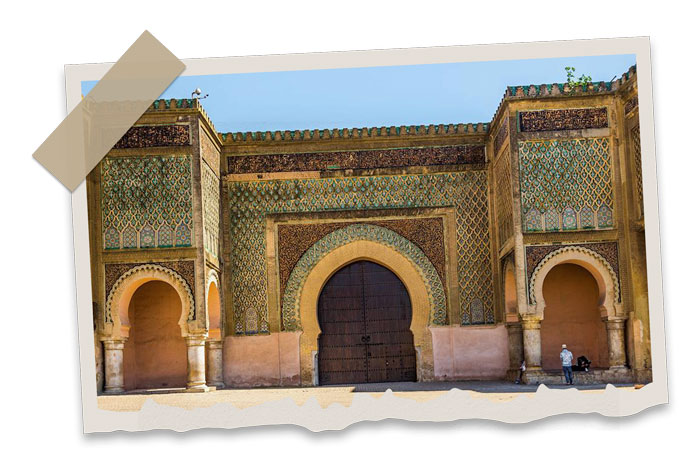
3. Sehrij Es-Sawani
Sehrij Es-Sawani is a massive water reservoir and granary complex located just outside Meknes’ city walls. Built under Sultan Moulay Ismail in the late 17th century, it was designed to provide both water and grain for the imperial city and the Sultan’s extensive cavalry. The site features vast vaulted halls, precise masonry, and functional yet elegant architecture, reflecting the engineering brilliance of the Alaouite era. Walking through the complex, visitors can appreciate the scale and ambition of Moulay Ismail’s urban planning. Sehrij Es-Sawani not only served practical purposes but also showcased the Sultan’s power and organizational skills. Today, it stands as a testament to Meknes’ imperial heritage and the sophisticated infrastructure that supported its historic grandeur. Exploring this site offers a unique glimpse into the logistics and daily life of a 17th-century Moroccan capital.
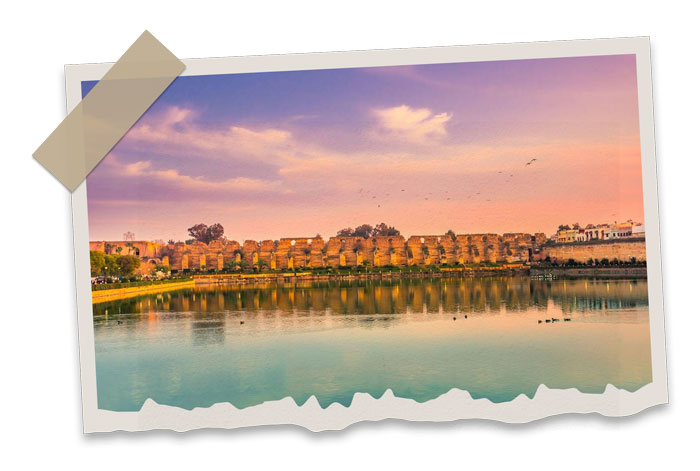
3. Moulay Ismail Mausoleum
The Mausoleum of Moulay Ismail is one of Meknes’ most revered historical sites and a rare royal tomb open to non-Muslim visitors. Located within the old city, it serves as the final resting place of Sultan Moulay Ismail, the ambitious ruler who transformed Meknes into an imperial capital. The mausoleum’s walls are adorned with intricate carved plasterwork, delicate cedar wood, and vibrant zellij tile mosaics, showcasing the exceptional craftsmanship of the Alaouite dynasty. Inside, the serene atmosphere and ornate decoration create a sense of reverence and grandeur. Visitors can admire the harmonious blend of Islamic artistry and Moroccan architectural detail. The site also reflects the spiritual significance of Meknes during Moulay Ismail’s reign. Every corner tells a story of power, devotion, and historical legacy. It remains a must-see destination for history lovers exploring the imperial city.
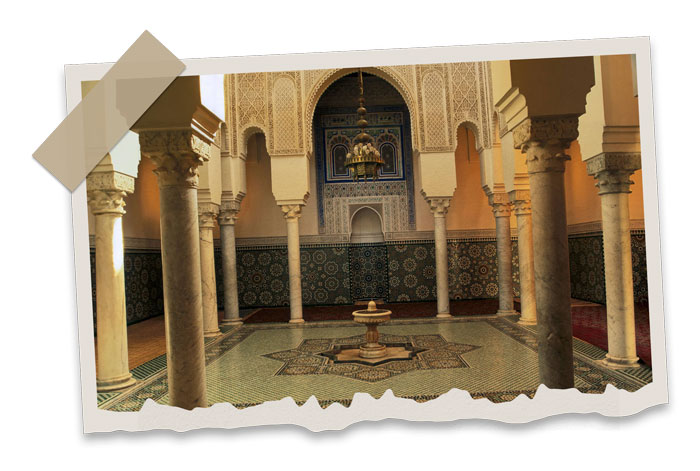
Discover Meknes – Morocco’s Hidden Historical Gem!
Ready to explore the underrated Moroccan city every history lover should visit? Step off the beaten path and wander through Meknes’ UNESCO-listed medina, monumental gates, grand palaces, and hidden gems. Pair your visit with a trip to Volubilis and Moulay Idriss Zerhoun for a truly immersive historical experience.
Book your Meknes adventure today and uncover the stories, architecture, and traditions that make this city a must-see destination for history enthusiasts.
4. The Medina
The historic medina of Meknes is a UNESCO World Heritage Site and the heart of the city’s rich cultural and architectural heritage. Its narrow, winding streets are lined with traditional Moroccan houses, bustling souks, and centuries-old artisan workshops where craftsmen still practice age-old trades. Unlike the crowded medinas of Marrakech or Fes, Meknes’ medina feels intimate and authentic, allowing visitors to explore at a relaxed pace. Every alleyway reveals hidden gems, from ornate riads to small cafes and local markets. The medina also showcases the city’s distinctive architectural style, blending Islamic, Moorish, and Andalusian influences. Walking through its lanes, travelers can feel the pulse of Meknes’ history and the daily rhythm of its residents. For history enthusiasts, it offers an immersive experience that connects the present with centuries of Moroccan tradition. The medina is not just a place to see—it’s a space to experience history firsthand.
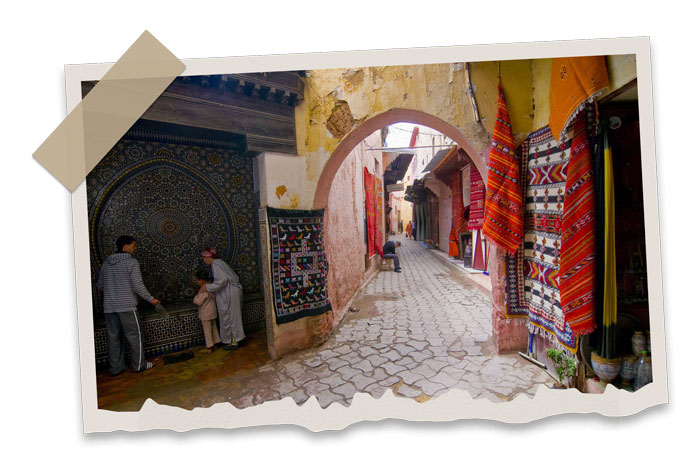
5. Nearby Volubilis
Just a short drive from Meknes lies Volubilis, one of the best-preserved Roman ruins in North Africa. This ancient city dates back to the 3rd century BCE and was later expanded under the Roman Empire, serving as a thriving administrative and agricultural center. Walking among its mosaics, triumphal arches, and temples, visitors can trace layers of history that predate Meknes’ imperial glory. The site provides a remarkable contrast to Meknes’ Alaouite-era architecture, highlighting the region’s long and diverse historical legacy. Volubilis’ expansive ruins reveal the scale and sophistication of Roman urban planning, including forums, basilicas, and intricate housing complexes. Its location near Moulay Idriss Zerhoun, Morocco’s first Islamic settlement, adds a spiritual and cultural dimension to the visit. History enthusiasts can spend hours exploring Volubilis, marveling at the mosaics and imagining life in one of Morocco’s earliest cities. A trip to Meknes is incomplete without a visit to this ancient Roman treasure, which complements the city’s imperial heritage perfectly.
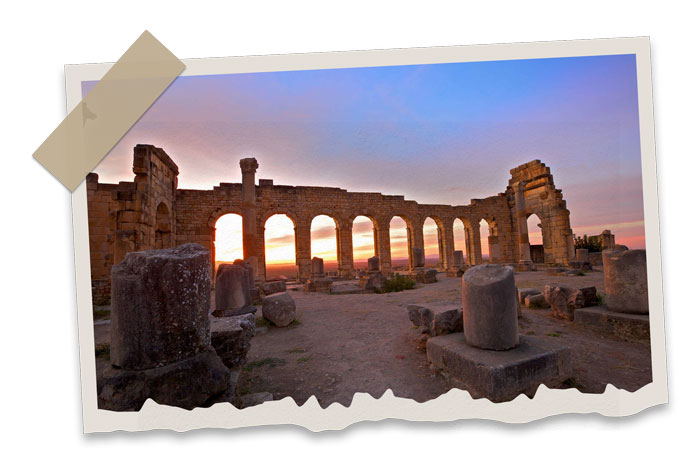
Meknes’ Cultural & Architectural Heritage
Meknes’ cultural and architectural heritage reflects a unique blend of Islamic, Moorish, and Andalusian influences, shaped over centuries of dynastic rule. The city’s medina, with its winding alleys, traditional riads, and artisan workshops, preserves the essence of Moroccan urban life. Palaces and monumental gates like Bab Mansour showcase the grandeur of Sultan Moulay Ismail’s imperial vision, combining functional design with ornamental artistry. Andalusian gardens, such as those surrounding the royal palaces, add serene green spaces that balance the city’s stone architecture. Throughout Meknes, intricate zellij tilework, carved plaster, and cedar wood detailing highlight the skill of local craftsmen. The city also maintains living traditions, from pottery and weaving to local culinary practices, offering travelers an authentic cultural experience. For history lovers, Meknes is not just a collection of monuments—it is a living museum where architecture, art, and everyday life intertwine.
Experiences for History Lovers Beyond Monuments
Meknes offers history lovers more than just grand gates, palaces, and mausoleums—it is a city where the past comes alive through everyday experiences. Wandering through the medina’s narrow streets, visitors can watch artisans craft traditional pottery, carpets, and metalwork using techniques passed down for generations. Stopping at local cafés and markets provides a glimpse into daily life, connecting the present with centuries of tradition. A short excursion to Moulay Idriss Zerhoun, Morocco’s first Islamic settlement, deepens understanding of the region’s spiritual and cultural roots. Just outside the city, the Roman ruins of Volubilis allow travelers to walk in the footsteps of ancient civilizations, exploring mosaics, temples, and triumphal arches. Seasonal festivals, such as religious or cultural celebrations, offer insight into living customs that have persisted for hundreds of years. Even a quiet evening stroll through the medina or along the imperial walls immerses visitors in Meknes’ historic atmosphere. These experiences allow history enthusiasts to feel the city’s rich past in a tangible and memorable way.
Practical Travel Tips for Visiting Meknes
Visiting Meknes is straightforward, but a few tips can help history lovers make the most of their trip. The best time to visit is during spring (March to May) or autumn (September to November), when the weather is mild and pleasant for exploring both the city and nearby sites like Volubilis. A 2–3 day stay is ideal to fully appreciate the imperial monuments, medina, and surrounding attractions without rushing. Meknes is easily accessible by train or car from Fes, Casablanca, or Rabat, making it a convenient addition to any Moroccan itinerary. When exploring the medina, wear comfortable shoes for walking on cobblestone streets and bring cash for small purchases at artisan shops. Hiring a local guide can provide deeper historical context and reveal hidden gems often missed by independent travelers. Don’t forget to visit the UNESCO-listed medina, Bab Mansour, Moulay Ismail Mausoleum, and Sehrij Es-Sawani for a complete historical experience. Lastly, balance your trip with visits to nearby sites like Volubilis and Moulay Idriss Zerhoun to fully appreciate the region’s layered history.
Why History Enthusiasts Will Love Meknes
Meknes is a treasure trove for history lovers because it offers a rare combination of imperial grandeur and authentic local life. Unlike more tourist-heavy Moroccan cities, it allows visitors to explore historical sites at a relaxed pace, making every palace, gate, and medina alley feel personal and immersive. The city’s monuments, from Bab Mansour to Sehrij Es-Sawani, reflect the ambition of Sultan Moulay Ismail and provide a tangible connection to Morocco’s imperial past. Its UNESCO-listed medina preserves centuries-old traditions, artisan crafts, and architecture, offering a living experience of Moroccan history. Nearby sites like Volubilis and Moulay Idriss Zerhoun add layers of Roman and Islamic heritage, enriching the historical journey. Meknes also showcases the blend of Islamic, Moorish, and Andalusian influences that make Moroccan architecture so unique. For travelers who want to feel history rather than just see it, Meknes delivers an intimate, multifaceted, and unforgettable experience.
Conclusion
Meknes stands as Morocco’s underrated historical gem, offering travelers a unique window into the country’s imperial past. From its UNESCO-listed medina and monumental gates to the Mausoleum of Moulay Ismail and the sprawling Royal Stables, the city is a living testament to centuries of craftsmanship, culture, and dynastic ambition. Unlike the busier tourist hubs, Meknes provides an authentic and intimate experience, allowing history enthusiasts to truly connect with its stories and streets. Pairing the city with nearby Volubilis and Moulay Idriss Zerhoun creates a rich, layered journey through Morocco’s Roman, Islamic, and imperial heritage.
For travelers who want to go beyond the usual destinations, Meknes is the perfect choice. Step off the beaten path, wander through the medina, marvel at imperial architecture, and let the history of Meknes captivate you. Add this underrated Moroccan city to your itinerary and experience a side of Morocco that is both majestic and authentic—before the world fully discovers it.
Discover Meknes – Morocco’s Hidden Historical Gem!
Ready to explore the underrated Moroccan city every history lover should visit? Step off the beaten path and wander through Meknes’ UNESCO-listed medina, monumental gates, grand palaces, and hidden gems. Pair your visit with a trip to Volubilis and Moulay Idriss Zerhoun for a truly immersive historical experience.
Book your Meknes adventure today and uncover the stories, architecture, and traditions that make this city a must-see destination for history enthusiasts.
